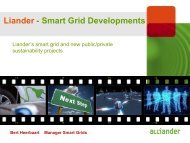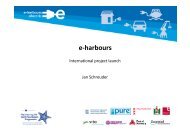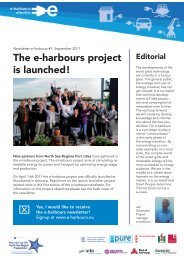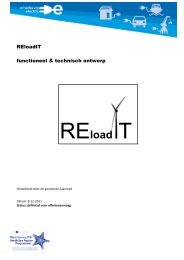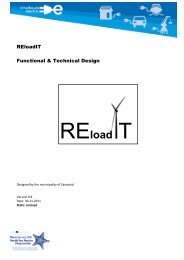renewable energy in zaanstad: from theory to practice - e-harbours
renewable energy in zaanstad: from theory to practice - e-harbours
renewable energy in zaanstad: from theory to practice - e-harbours
Create successful ePaper yourself
Turn your PDF publications into a flip-book with our unique Google optimized e-Paper software.
1. INTRODUCTION<br />
The <strong>energy</strong> challenge is one of the greatest tests faced by the world <strong>to</strong>day. The quality of life,<br />
<strong>in</strong>dustrial competitiveness and the overall function<strong>in</strong>g of society are dependent on safe, secure,<br />
susta<strong>in</strong>able and affordable <strong>energy</strong>. Depletion of fossil fuels causes ris<strong>in</strong>g <strong>energy</strong> prices and makes<br />
countries more and more dependent on <strong>energy</strong> import. Besides this, global warm<strong>in</strong>g is worldwide<br />
recognized as a serious problem. Key decisions have <strong>to</strong> be taken <strong>to</strong> reduce drastically our emissions<br />
<strong>to</strong> fight climate change and <strong>to</strong> secure current en future generations of save and affordable <strong>energy</strong><br />
supply for citizens and bus<strong>in</strong>esses.<br />
The European Council <strong>in</strong> 2007 adopted ambitious <strong>energy</strong> and climate change objectives for 2020. The<br />
objectives <strong>in</strong>clude a reduc<strong>in</strong>g of greenhouse gas emissions by 20%, an <strong>in</strong>crease of the share of<br />
<strong>renewable</strong> <strong>energy</strong> <strong>to</strong> 20% and an <strong>energy</strong> efficiency improvement of 20% [8]. This is a step <strong>in</strong> right<br />
direction; however, the <strong>energy</strong> challenge <strong>in</strong>volves more. The worldwide <strong>in</strong>creas<strong>in</strong>g <strong>energy</strong> demand<br />
<strong>to</strong>gether with the <strong>in</strong>creas<strong>in</strong>g share of <strong>renewable</strong> <strong>energy</strong> causes serious challenges for the electricity<br />
<strong>in</strong>frastructure. It will require enormous <strong>in</strong>vestments <strong>to</strong> prepare the current transmission and<br />
distribution grids for this <strong>in</strong>crease, which were <strong>in</strong>stalled decades ago. Besides this, the consequence<br />
of the <strong>in</strong>creas<strong>in</strong>g share of <strong>renewable</strong> <strong>energy</strong> is the transition <strong>from</strong> centralized electricity production<br />
<strong>in</strong> large scale power plants <strong>to</strong> distributed generation (DG). Small scale Pho<strong>to</strong> Voltaic (PV) systems and<br />
onshore w<strong>in</strong>d turb<strong>in</strong>es are <strong>in</strong>stalled on the electricity distribution network. The difficulty of accurate<br />
forecast<strong>in</strong>g and the variability of production can have negative impact on the current medium and<br />
low voltage networks <strong>in</strong> terms of capacity and power quality. The concept of Smart Grid can help <strong>to</strong><br />
enable the implementation of <strong>renewable</strong> distributed genera<strong>to</strong>rs by reduce the impact on the<br />
distribution networks.<br />
As result of the goals set by the European Union; national governments, organizations and local<br />
municipalities are start<strong>in</strong>g pilot projects <strong>to</strong> enhance the development of <strong>renewable</strong> <strong>energy</strong> and Smart<br />
Grids. The municipality of Zaanstad has set the ambitious goal of be<strong>in</strong>g a CO2 neutral municipality by<br />
2020. In the context of this <strong>energy</strong> policy Zaanstad is lead<strong>in</strong>g the European project e-<strong>harbours</strong>. E<strong>harbours</strong><br />
is a project which <strong>in</strong>volves seven harbour cities who share the same objective of stimulat<strong>in</strong>g<br />
local <strong>renewable</strong> <strong>energy</strong>, smart mobility and Smart Grid deployment. Each of these cities is currently<br />
develop<strong>in</strong>g their own showcase. The municipality of Zaanstad – which is project leader – is<br />
develop<strong>in</strong>g the Smart Grid pilot project REloadIT. This pilot project focusses on charg<strong>in</strong>g electric<br />
vehicles by solar and w<strong>in</strong>d <strong>energy</strong> and uses Smart Grid technologies <strong>to</strong> facilitate this <strong>in</strong> a smart way.<br />
This report will focus on Zaanstads plan <strong>to</strong> become a CO2 neutral municipality by 2020. In chapter 2<br />
the <strong>energy</strong> policy of Zaanstad <strong>to</strong>gether with the <strong>energy</strong> consumption with<strong>in</strong> the municipality will be<br />
reviewed. In chapter 3 a possible way will be described of how Zaanstad can achieve this objective. In<br />
this chapter the potential of <strong>energy</strong> sav<strong>in</strong>gs <strong>to</strong>gether with the potential of <strong>renewable</strong> <strong>energy</strong><br />
deployment <strong>in</strong> Zaanstad will be <strong>in</strong>vestigated. In chapter 4 the concept of Smart Grid and its<br />
capabilities will be def<strong>in</strong>ed accord<strong>in</strong>g <strong>to</strong> the literature. In chapter 5 the Smart Grid pilot project<br />
REloadIT will be described. The last chapter consists of a research proposal, which exists of<br />
<strong>in</strong>vestigations on the practical implementation of <strong>renewable</strong> distributed genera<strong>to</strong>rs <strong>in</strong> Zaanstad and<br />
the potential of role of Smart Grids with<strong>in</strong> the municipality.<br />
6



